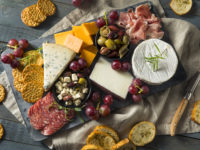Oregon Ice Cream Co. has something for everyone
Oregon Ice Cream Co., known for its flagship Alden’s Organic brand, has a data-driven, consumer-focused approach to product development.










Journey to any grocery store today and you’ll find plenty of organic product options tucked next to conventional offerings. But when Oregon Ice Cream Co. launched the Alden’s Organic ice cream brand in 2004, it was offering something fairly novel to the market.
“The founders … had a steadfast belief in organic, well ahead of their time. It gave them a strong point of difference in the marketplace to what was available in that space at the time,” says Joelle Simmons, senior vice president of sales and marketing.
Appropriately based in Eugene, Ore., a city known for its progressive culture, Oregon Ice Cream — which also produces Cascade Glacier, a brand of ice cream available only through foodservice distribution and scoop shops, and offers co-packing services — was a pioneer in the organic ice cream and novelty space, says Eric Eddings, president and CEO. Its roots in ice cream production actually date back to 1938, when the company’s current ice cream plant began producing Dutch Girl Ice Cream.
In 2014, the company was sold to Branch Brook Holdings LLC, formed through a strategic partnership among Swander Pace Capital, United Natural Foods Inc. and Jefferson Capital Partners. According to Eddings, this change in ownership supported Oregon Ice Cream through a period of significant growth.
In 2015, the Alden’s Organic brand got into conventional stores “in a very significant way,” notes Simmons. It is now the No. 1 selling organic ice cream brand in the natural channel, and is available in over 10,000 natural, specialty and traditional stores.
Two brands become one
Prior to 2019, Oregon Ice Cream offered two retail brands: Alden’s Organic and Julie’s Organic. Alden’s Organic focused on “sharing-size ice cream,” notes Simmons, offered in 48-ounce sqrounds. Julie’s Organic, on the other hand, was dedicated to personal-sized frozen desserts such as frozen novelties and ice cream pints.
Before making the decision to combine the brands under the Alden’s Organic name, Oregon Ice Cream brought in industry experts to conduct qualitative and quantitative research, Simmons says. They looked at the strengths of both brands and what the future could look like for each of them.
“Both were known in the communities and with our consumers, but it was really clear that the affiliation and platform strength was centered around the Alden’s brand,” says Eddings. “So, in 2019 and 2018, we began that consolidation of the two brands. … We took the best-in-class in [Julie’s] novelty side and we brought them into the Alden’s family.”
As part of the brand consolidation, Oregon Ice Cream launched a campaign called “All in with Alden’s” to communicate to consumers and retailers that the Alden’s brand now offered it all — from novelties to pints to sharing-size ice cream. Simmons says retailers were overwhelmingly supportive of the change.
The relaunched Alden’s Organic brand now offers 46 SKUs, Eddings notes. These include 12 48-ounce sqrounds, 10 14-ounce dairy pints (which were launched in 2018), seven ice cream bars and seven ice cream sandwiches. The sandwiches are offered in three formats — rounds, rectangles and squares.
“And then we launched dairy-free [products] this year in the natural channel of trade,” says Simmons. “We are starting out with seven dairy-free 14-ounce flavors, two dairy-free sandwiches and one dairy-free bar that we actually already had in the Alden’s lineup, and it’s amazing.”
The dairy-free launch was one of the company’s more recent successes. While Oregon Ice Cream is still focused on dairy products, “Alden’s wanted to have something for everyone,” explains Simmons, and that meant developing options for people who don’t eat dairy because of dietary issues or preferences.
And Alden’s Organic’s introduced three new dairy flavors this February that also have been successful: Ooey Gooey Brownie, Peachy Keen Twist and Old Fashioned Vanilla. The company is planning more flavor introductions in the next year, Simmons says.
“We’re really taking an aggressive approach to line extensions. Our consumers and retailers want more,” she notes. “We believe, for 2021, that we’ve got the right platforms and that we need to add some depth to the breadth that we already have.”
Stages of product development
Before introducing new products to market, Oregon Ice Cream uses a robust five-step process similar to the Stage-Gate process to ensure it can produce the offerings successfully. It normally takes six to eight months for a product to reach final approval, explains Amber Everly, vice president of quality assurance and technical services.
“We do our homework. That’s one of the things I’m so proud of: We try to do very few —if any — things by accident,” Eddings adds.
Developing products begins with listening to the consumer, says Kim Berry, director of brand. Alden’s Organic fans are very engaged on social media and via email, and the company aims to have a two-way conversation with them. Listening to consumer feedback prompted the company to create dairy-free options, for example.
In addition to getting ideas from consumers, Alden’s Organic looks at data and trends to see what flavor profiles are doing the best, Berry says. The company not only researches frozen dessert trends, but also pays attention to the dessert space in general, along with what’s popular in liquid dairy and snacking products.
When developing new flavors, the company prioritizes adding in an “Alden’s twist,” meaning a playful ingredient such as “a ribbon of variegate that you weren’t expecting,” Simmons says.
Oregon Ice Cream’s “secret weapon” is its senior scientist, who takes these ideas and concepts and turns them into new flavors in the research and development (R&D) lab, Simmons says. Once he’s developed a small-scale sample of a potential new product, he takes it to the larger team for their review.
“And that’s our gate one. Then if it’s a yes, we move into stage two, and that’s the validation,” says Everly. “That’s where we’re developing the product calculators and putting benchtops together here in our lab. [We start] to reach out to suppliers and vendors and work really closely with them to develop unique organic ingredients and inclusions.”
When Dairy Foods visited Oregon Ice Cream, the team had just approved 17 flavors to move on to stage two of the R&D process for potential release in 2021.
Validation and testing
One of the biggest challenges in the validation stage is finding the materials in organic form and at a good price point, says Charles Nutter, senior vice president of operations. Sometimes the company will have to tweak recipes because a given product is not available organic, or at the level of quality Oregon Ice Cream expects of its Alden’s Organic brand.
“There’s so many things we’d like to make, but [we] can’t find it at a price that [we] can,” Nutter adds.
Another important part of stage two is involving the operations team in figuring out how a product can be made with the plant’s equipment. For example, figuring out how to add in variegates and inclusions is “an art as much as it is a science,” Nutter explains.
If a product makes it through validation, it moves to stage three: testing. This is when a product goes through line trials to ensure it can be made successfully in the plant, Everly says. The operations team will start with an initial formula, but often will tweak it until the product comes out perfectly.
“If we need to do that line trial twice, or three or four [times], we’ll do that in order to get the product right,” Everly says.
Once the product is consistently made the way Oregon Ice Cream wants it, it passes through to the next stage, which is commercialization. At this point, the company starts looking into packaging design, Everly explains. It also makes sure it has all its necessary certifications — such as organic, kosher and/or vegan — in order.
After passing through the fourth stage, the product is ready for its first run, or the final stage in the R&D process. During this stage, the R&D team continues to monitor production to ensure the product is produced consistently every time.
“Stage five is the monitoring for the next three runs, really perfecting that repeat quality so that the consumers are getting what they expect every time,” Everly says.
Once consistency is ensured, the product is officially released from the R&D team to operations, and is ready to be part of the plant’s regular production lineup.
Marketing strategies
Oregon Ice Cream’s approach to marketing Alden’s Organic also is very data-driven. The company spent four months conducting consumer research to understand its customer base, for example. This included holding focus groups, conducting online surveys and even going into customers’ houses to see what else was in their freezers, says Berry. Through this, the company discovered that its typical customer is a “goodness seeker.”
“They are all about quality and doing good within their communities, within their families,” she explains. “They’re very connected, and they’re always thinking about others, not just themselves.”
Additionally, the “goodness seekers” like to indulge, but are attracted to the certified organic promise of Alden’s Organic’s products, Berry notes. They’re 60% female and many of them are married, college-educated and have young children in the house.
“This consumer is very valuable to our retailers,” Simmons adds. “They shop often, and their baskets are some of the highest-ranked baskets that come through because they’re going to have a very nice bottle of wine in there. They’re going to have fresh produce. They’re purchasing organic, and they are purchasing conventional all over the store.”
According to Eddings, it was essential for Oregon Ice Cream to understand its Alden’s Organic consumer because it enables the company to build its brand and bring even more people into the family.
“You really need to know who they are and how you can actually engage with them,” he adds.
The company has focused its marketing efforts around social media, mainly utilizing Facebook, Twitter and Instagram, Berry says. The engagement rates on these platforms have grown exponentially every month. The social media strategy for Alden’s Organic involves ensuring that customers are able to taste the products. With this is in mind, the company does a lot of giveaways on social media such as free ice cream for a year.
“One of the best things that we can do is to put the product in people’s mouths,” says Berry. “So there’s a huge effort in ensuring that if we hear from a consumer, we’ll make sure that [they can] get the products.”
Additionally, Oregon Ice Cream partners with like-minded companies and social media influencers to get the word out about Alden’s Organic’s products. It posts user-generated content, too.
“We just started a series called ‘Fridays with the Fam,’” notes Berry. “We highlight some of those user-generated pieces. We’ll highlight some of our employees. Really, [we’re] opening up our arms to say, ‘If you’re engaging with us, we want to celebrate that.’”
Not just dessert
In the future, Oregon Ice Cream wants to build on the concept of “Alden’s for all,” says Eddings. This means opening up more usage occasions for its products. The company is particularly interested in the contemporary snacking trend and thinks that Alden’s Organic’s products make the perfect snack.
“We want to get out of being pigeonholed just as dessert,” Simmons adds.
Right now, the company sees three primary eating occasions as a fit for the Alden’s Organic brand. There are sharing moments, which call for a 48-ounce ice cream sqround that can be doled out to party guests or family members. There are times of personal indulgence, when a customer might gravitate toward an Alden’s Organic 14-ounce pint. And then there are snacking occasions, which call for the portion control of a frozen novelty.
“Alden’s wants to be a brand that can be a part of every eating occasion, [offering] a solution for our ‘goodness seeker’ in everything they do,” Simmons says. “If they are holding a birthday party, or having dessert after dinner, or handing out snacks after school … we [want to be] part of sharing moments and life moments with our consumers.”
Looking for a reprint of this article?
From high-res PDFs to custom plaques, order your copy today!











